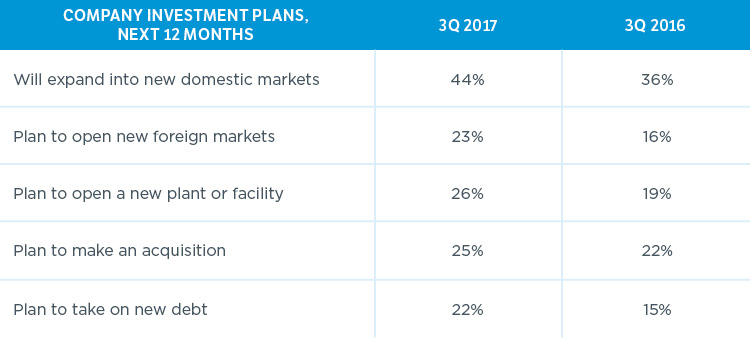As of this date—October 2017—the U.S. economy has expanded
for one hundred consecutive months. That is the third-longest
period of uninterrupted growth in U.S. economic history. The
longest, 120 months, came in the 1990s; the expansion of the
1960s lasted 106 months. The current expansion has not been
rapid; no one would call it a boom. It has not been evenly
distributed across places and populations. But it has been
extraordinarily long-lived.
It has also been led by middle market companies. In the last
five years, non-farm employment in the United States has
increased from 142 to 154 million—roughly eight percent. The
middle market has added jobs at a rate of 5.5% a year. That
figure includes inorganic growth, so it is not apples-to-apples
with overall employment. But quarter after quarter, comparable
data show middle market employment rising at least twice as
fast as employment in smaller or bigger companies. The same
holds for top-line growth, which for the middle market has
dipped below 6% only four times in the last 20 quarters.
We have noted before how benign the economic climate has
been, with negligible inflation, persistently low costs for capital,
talent, and energy, and robust equity markets. (This this is the
second-longest bull market in history.) Microeconomic signals
are green, too. Executives expect profits to rise faster than
costs. Forty-one percent of companies say their new-order
pipeline has grown, a number that is 10 full percentage points
higher than it was at this time in 2016. Among those with fuller
pipelines, the average increase is a very robust 13.2%.
Given all this, it is no wonder that middle market executives
expressed this quarter their highest-ever level of confidence
in their local economies, second-highest ever confidence in
the global economy, and third-highest-ever confidence in the
U.S. economy. They also say that they will back that confidence
with actions designed to secure and extend their growth.

These are plans, not promises; but historically middle market
companies have kept close to plan. For example, a year ago
37% planned new domestic expansion, and 36% actually did it.
This worm will turn; worms always do. While the middle market
does not seem to face macroeconomic headwinds, there are
considerable uncertainties. Company valuations, sovereign
debt, and political risk all are high. Trade agreements are being
challenged. These or other factors could put an end to the
good times, and they will be obvious only in retrospect, and
out of executives’ hands. Two major challenges are more under
executives’ control.
The first challenge: Talent shortages. Four out of 10 executives
say a lack of talent constrains their growth. Executives cannot
do much about workforce participation rates, which are
affected by factors like an aging population, immigration, and
labor lost to opioid addiction. But only 35% of middle market
job vacancies are filled by promotion from within, which
suggests companies experiencing labor shortages should
rely less on the tight outside labor market and invest more in
training, developing career paths for employees, and enhancing
the employee value proposition to increase retention.
The second challenge: The middle market, like the rest of the
economy, is not getting much in the way of labor-productivity
improvement. For the last two quarters, revenue growth
and employment growth have converged. In 2014, we noted
that job growth was trailing revenue grow substantially—in
the third quarter of 2014, the two numbers were 7.5 and 3.5,
respectively. At that time we wondered if executives were
being too cautious about hiring. Now it appears that they are
getting fewer gains in productivity than they should—perhaps
an indication that they are holding back on capital spending.
The paradox: If they could solve the productivity problem, they
would also reduce the talent-shortage problem.